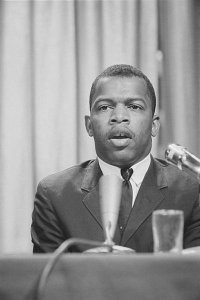ERIC SUNQUIST: After King finished, reported Lerone Bennett, Jr., grown men and women “wept unashamedly.” No doubt Time magazine could have chosen a more appropriate metaphor in reporting that King “enslaved his audience,” but this was true even of those who feared his message. Because of its power to influence the masses, concluded the head of the FBI’s Domestic Intelligence Division, King’s “demagogic speech” made him the nation’s “most dangerous Negro.” MORE
Historian Howard Zinn wrote: “At the great Washington March of 1963, the chairman of the Student Non-Violent Coordinating Committee (SNCC), John Lewis, speaking to the same enormous crowd that heard Martin Luther  King’s I Have a Dream speech, was prepared to ask the right question: ‘Which side is the federal government on?’ That sentence was eliminated from his speech by organizers of the March to avoid offending the Kennedy Administration. But Lewis and his fellow SNCC workers had experienced, again and again, the strange passivity of the national government in the face of Southern violence.”[2]
King’s I Have a Dream speech, was prepared to ask the right question: ‘Which side is the federal government on?’ That sentence was eliminated from his speech by organizers of the March to avoid offending the Kennedy Administration. But Lewis and his fellow SNCC workers had experienced, again and again, the strange passivity of the national government in the face of Southern violence.”[2]
“John Lewis and SNCC had reason to be angry. John had been beaten bloody by a white mob in Montgomery as a Freedom Rider in the spring of 1961. The federal government had trusted the notoriously racist Alabama police to protect the Riders, but did nothing itself, except to have FBI agents take notes. Instead of insisting that blacks and whites had a right to ride the buses together, the Kennedy Administration called for a ‘cooling-off period,’ a moratorium on Freedom Rides.[2]
